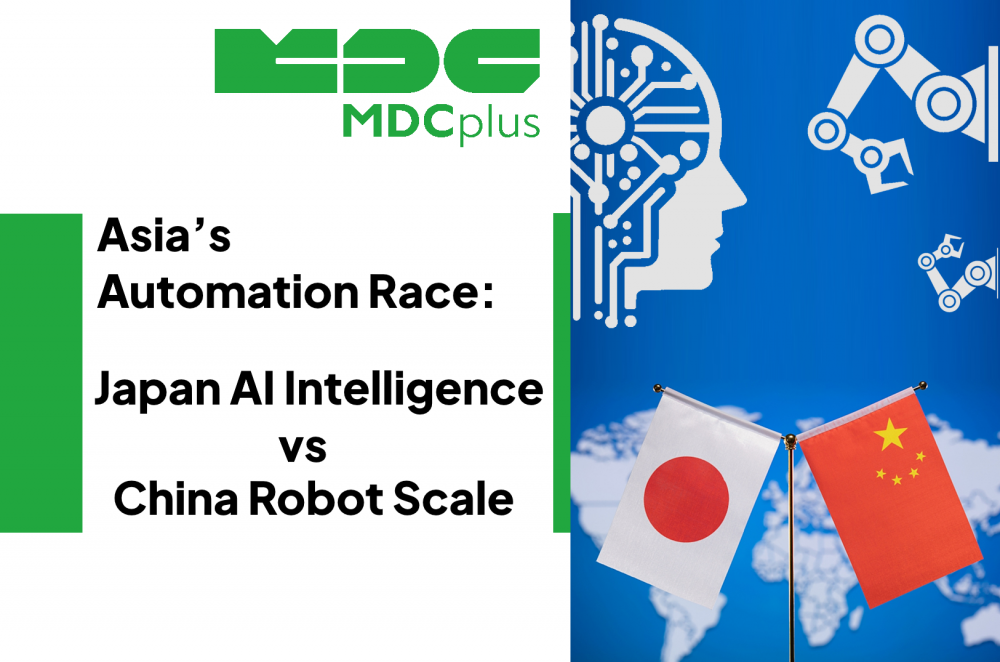Asia’s Automation Race: Japan AI Intelligence vs China Robot Scale
Two real developments define where industrial automation is headed right now. In Japan, Nvidia and Fujitsu agreed to build foundational AI infrastructure and smart robotics with an explicit path into factory use cases. In China, robot installations are compounding at global-leading pace, putting sheer volume to work across automotive, electronics, and general manufacturing. Net effect: the next competitive cycle is not “robots or AI” – it is robots with AI, deployed either with depth of intelligence (Japan) or breadth of coverage (China).
Japan’s play: build smarter factories, not just more robots
The Nvidia–Fujitsu partnership frames a national push to embed AI into industrial workcells – vision, motion planning, adaptive control, and edge inference – while standing up domestic compute capacity to run it. For plant leaders, the signal is clear: expect tighter coupling between AI models, robots, and MES, with Yaskawa and other Japanese OEMs likely in the integration mix. Timeline matters too – the partners called out 2030 for a mature AI infrastructure footprint in Japan.
What this means on the floor
- Faster program changes without re-teaching entire cells
- Closed-loop quality using vision + anomaly detection
- Safer human-robot collaboration driven by perception models
China’s play: scale automation everywhere
China continues to install roughly half of the world’s industrial robots annually, with domestic vendors capturing a growing share at lower price points. That scale isn’t just headline optics – it is cascading into lower unit costs, denser automation in tier-2/3 suppliers, and export competitiveness in categories that typically migrate away as wages rise. Robot density is catching up to leaders while total stock passes 2 million units.
What this means for competitors
- Price pressure intensifies as automated Chinese plants widen cost gaps
- Lead times improve as more mid-tier factories automate intralogistics and assembly
- Talent mixes shift toward “purple-collar” robot techs and line optimizers
The real takeaway: integration beats point solutions
This isn’t a beauty contest between two countries. It’s a map of two valid strategies that converge on the same destination – AI-driven, data-connected automation. Japan is stacking intelligence per cell; China is blanketing production with robots. The winner in any region will be the plant that blends both: enough coverage to lift throughput and enough intelligence to keep quality tight and changeovers fast.
Operator’s checklist – how to act on this now
- Pair AMRs/cobots with vision AI instead of buying more standalone robots. You’ll get flow plus first-pass yield gains.
- Wire robots to your MES and quality stack. If your robot data isn’t in your SPC and downtime analytics, you’re leaving money on the table.
- Pilot an AI “agent” for engineering ops – program documentation, changeover checklists, parameter lookups. Treat it like a cell teammate, not a toy.
The Big Picture: Two Paths, One Direction
What Japan and China are doing differently in 2025 actually points to the same outcome — an irreversible shift toward intelligent, data-driven automation.
- Japan focuses on building smart ecosystems that integrate AI into every operational decision.
- China focuses on scaling robotics across the industrial base to reach automation density at national scale.
In practice, these strategies will converge. As Japan’s AI-driven systems mature and China’s robot fleets gain intelligence, the divide between “intelligent” and “mass” automation will disappear. Every region will need both – the depth of insight and the breadth of coverage.
Intelligence Is the New Efficiency
The automation race in Asia isn’t about who installs the most robots or who builds the smartest one. It’s about how manufacturing intelligence spreads across the production network — from individual robots to entire ecosystems.
Factories that still treat automation as a cost-saving project will struggle to keep up. The next generation of leaders will see it as an adaptive system — learning, communicating, and improving in real time.
That’s where the industrial world is heading:
- Japan is proving that AI makes robots strategic.
- China is proving that robots make economies resilient.
Together, they’re defining the new baseline for global manufacturing — where speed, flexibility, and intelligence are no longer separate goals, but the same operating principle.
About MDCplus
Our key features are real-time machine monitoring for swift issue resolution, power consumption tracking to promote sustainability, computerized maintenance management to reduce downtime, and vibration diagnostics for predictive maintenance. MDCplus's solutions are tailored for diverse industries, including aerospace, automotive, precision machining, and heavy industry. By delivering actionable insights and fostering seamless integration, we empower manufacturers to boost Overall Equipment Effectiveness (OEE), reduce operational costs, and achieve sustainable growth along with future planning.
Ready to increase your OEE, get clearer vision of your shop floor, and predict sustainably?
